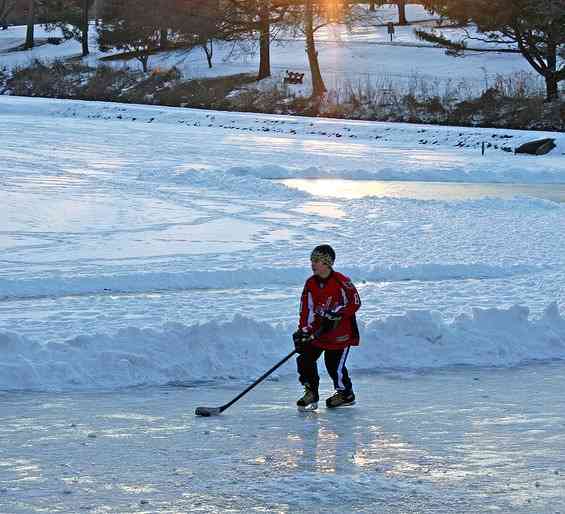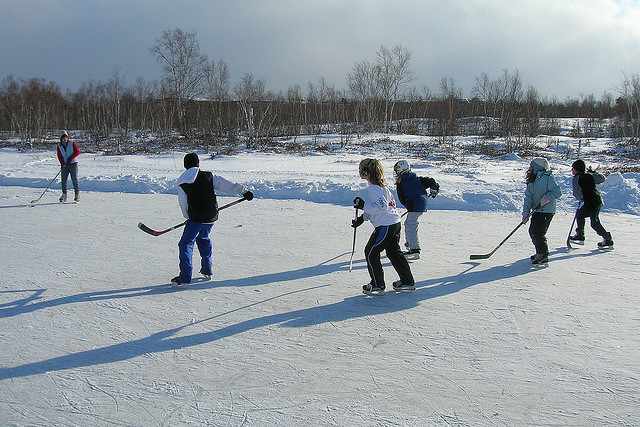Ice hockey marks the change of seasons in cold climates. As freshwater ponds and lakes freeze, hockey players of all ages gather their gear to play winter’s pastime. Outdoor ice hockey is like neighborhood soccer, schoolyard basketball and sandlot baseball. It is, in many ways, the spirit of the game.
Long before many of the most iconic players in the National Hockey League (NHL) took their first strides in a professional arena, they learned how to skate on frozen lakes, ponds and backyard rinks across North America and Europe. NHL legend Bobby Orr, for example, began skating at the age of four on the Seguin River in Parry Sound, Ontario. He often reminisces about the local game of “shinny,” referring to ice hockey played outdoors and often without pads or protection – just winter ski gear, skates and a “twig,” a common term for a stick amongst “hockey bros.”
“Most of the time we would be on the ice from early morning until darkness. Sometimes there would be 30 of us, chasing after the same puck,” said Orr, nicknamed the ‘King of Shinny.’
“If there were no more outdoor rinks, the memories would vanish. Ponds, lakes and outdoor rinks are where kids master their craft,” said minor league player and former Pennsylvania State Ice Hockey Captain Thomas Westfall. “Ice time in large arenas is also expensive so it’s not the limitless practice time you get outdoors.”
In an effort to preserve the outdoor game, the National Hockey League launched NHL Green™, an initiative to detail the environmental impacts and challenges of the sport, and to track the steps taken to become responsible for the tons of carbon emitted while conducting business.
Among the goals of NHL Green, launched January 1, 2010 with help from the Natural Resources Defense Council (NRDC), is to reduce the use of natural resources.
The NHL acknowledges that its hockey games are energy intensive. In its latest study, the 2014 NHL Sustainability Report, the league disclosed its big “carbon footprint” – approximately 530,000 metric tons of greenhouse gas emissions per year, including energy and water use, operational waste and nearly two million miles of team air travel per season.
 “It is an aspirational document, reporting on the meaningful ecological accomplishments achieved throughout the league during the past few years,” says NRDC’s Dr. Allen Hershkowitz. It is the “first ever such report produced by a professional sports league, and it illuminates an extraordinary level of commitment to responsible environmental stewardship by one of the most beloved and prominent sports leagues in the world.”
“It is an aspirational document, reporting on the meaningful ecological accomplishments achieved throughout the league during the past few years,” says NRDC’s Dr. Allen Hershkowitz. It is the “first ever such report produced by a professional sports league, and it illuminates an extraordinary level of commitment to responsible environmental stewardship by one of the most beloved and prominent sports leagues in the world.”
Leading by example, the league hopes to use its influence to inspire fans, partners and businesses to be environmentally conscious. The league has one of the largest and most passionate fan bases in all of professional sports. According to the report, there are 68 million NHL fans in North America, and the league’s total social media audience exceeds 10 million followers. The frozen fields on which the sport depends may be the unifier needed to ignite these millions toward environmental action.
The NHL is transparent about its vested interest in this cause. It believes its efforts toward sustainability are not only the right thing to do for the environment but for the long-term success of hockey. The league hopes to continue to host world-renowned outdoor hockey events such as the NHL Winter Classic, NHL Heritage Classic or NHL Stadium Series, played in iconic venues like Yankee Stadium and Soldier Field amongst others. These events have drawn huge crowds in recent years, such as the record setting 2014 Winter Classic at Michigan Stadium with an attendance of more than 105,000 people. The league also wants outdoor hockey to keep breeding creative and innovative skaters, rooted in the history and culture of the sport.
So maybe it’s a bit self-serving of the NHL to promote environmental change to protect the quality of its product, but there are worse things sports leagues – or any organization in a position of power – could be doing. The NHL has, and will hopefully continue to do its part and invites you to do yours: if not for future generations, for shinny’s sake.
Jessica Goddard is an avid online contributor on human interest topics including uplifting news, health and travel. She is passionate about spreading compelling and inspiring content to make cyberspace a worthwhile place.
Photos by Doug Eastick (top) and Randy von Liski (bottom), via CC licenses on Flickr





















